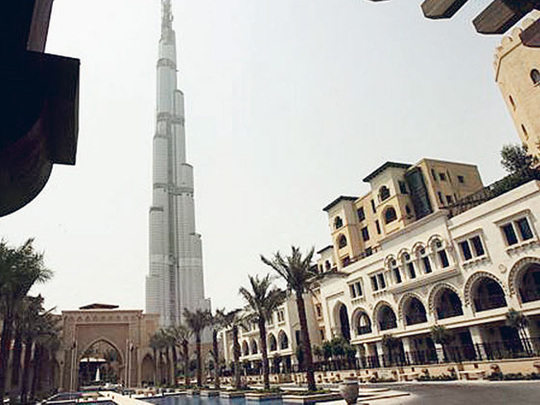
Acting as a guiding beacon to lost vehicles, the glistening facade of the Burj can be seen from almost any point in the emirate. After its opening, a lot of effort will need to be made to ensure that sparkle stays.
To date, the Burj Khalifa has only been cleaned by rope access, but is intended to be predominantly cleaned by building maintenance units (BMUs) with certain isolated areas to be maintained by rope access.
Ensuring the 23,000 glass panels that make up the Burj's exterior remain clean, Cox Gomyl has installed a number of BMUs located around the Burj's surface for both window washing and façade maintenance.
"The Burj Khalifa Tower is unique and there are no other buildings near the height and complexity of it. As an icon of Dubai which will no doubt host a stream of tourists, it's vital the façade remains clean at all times." says Theo van der Linde, Operations Manager at Cox Gomyl.
Depending on the level, Cox Gomyl has installed a variety of systems. The parapet-mounted sliding BMUs, which have been custom made for the Burj, are designed to access the lower levels up to 380m above ground level.
Positioned along three levels, (143, 252 and 380 metres) the machines, when not in use, are designed to be parked inside the building and then travel on customised tracks to the outside of the building.
The cleaning operators then travel down the facade in order to carry out their cleaning and maintenance duties. They are also fitted with a ‘materials hoist' which is used to replace broken glass panels on the Burj Khalifa Tower.
Hawk gantry machines
Further up, the Telescopic Boom Unit works between 643 and 682 metres. These are stationary and can rotate as well as extend and retract in order to reach all surfaces.
With an ability to clean between 701m and 740 metres high are the hawk gantry machines which have jibs that can rotate to clean the glass surrounding them. Davit systems which are placed between 749 and 759 metres high are the highest point where a BMU can be installed.
Under normal weather conditions, with all 18 BMU's in operation and 36 men manning the machines, the entire facade will take approximately two to three months to clean.
"The cleaning cycle is influenced by weather conditions; if we have a dust storm the windows will need to be cleaned more often; if we have a lot of rain the cleaning will be much faster. The normal cleaning cycle is 4 cycles per annum, always starting from the top going down to prevent dirty water from falling on clean windows. Also, during the summer, the windows become very hot so once water is applied to the glass it evaporates immediately. The cleaning cycle should follow the shaded area of the building," says Mr van der Linde.
"The BMUs, which took almost a year to install, had to be designed to operate in extreme conditions. Factors that had to be taken into account were wind speeds, movement of the building and extremely tight tolerances. The cleaning cycle also had to be taken into account given the size of the building," says Mr van der Linde.
Rope access
The very top of the Burj which is unreachable by ordinary window-washing cradles, is reserved for more adventurous window cleaners using rope access. The Burj Dubai has specific rope access anchorage on areas such as the spire that enable safe access to change the building's aircraft warning lights, aesthetic lights and general surface cleaning.
Cleaners are able to access the very top via an internal ladder equipped with a fall arrest device, up the 110-metre high and 2-metre diameter spire. A hatch gives access to the anchorage from where the ropes can be rigged to access the areas below.
"Surprisingly enough, there is not a lot of difference between cleaning and maintaining the 16th floor, as opposed to the 160th floor. The only consideration really is the wind where more points of attachment were required to ensure the abseilers' safety during wind unpredictability that is more frequently experienced at that height," Daniel Gill Business Development Manager at Megarme explains.
Megarme, which has technicians with an excess of 15 years' experience, is currently attempting to secure the tower's ongoing maintenance package.
All rope-access technicians are trained from scratch. The industry is governed by a number of global associations, the more respected and reputed being IRATA International (Industrial Rope Access Trade Association).
Megarme, who hold a Full IRATA Company Membership, have all their technicians individually trained, assessed and registered to an appropriate skill level and qualification and require constant refresher training and reassessment every three years to maintain that qualification.
Sun protection
To protect themselves from the sun, the technicians have to carry with them hydration packs supplying an electrolyte sport beverage and wear specialised clothing resembling moon suits. Work is planned around the positioning of the sun by using the natural shade of the buildings.
"Heat is the biggest threat to our safety when talking about natural elements. The municipalities have also implemented "stop work" breaks during the hotter months to attempt to avoid unnecessary heat related injuries.
However, it comes down to the education of the person responding to the indications of their body and the support of their team mates around them," says Gill.
"Working at heights has its additional dangers however, the biggest contributor to accidents in rope access is a lack of experience and training. Although working at extreme heights is no different to lesser heights it's often the individual's mind that hinders the most," Gill explains.












